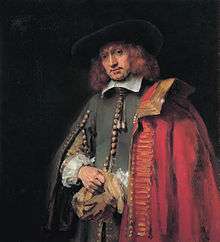Wet-on-wet



Wet-on-wet, or alla prima (Italian, meaning at first attempt), is a painting technique, used mostly in oil painting, in which layers of wet paint are applied to previously administered layers of wet paint. This technique requires a fast way of working, because the work has to be finished before the first layers have dried. It may also be referred to as 'direct painting' or the French term au premier coup (at first stroke).[1]
Wet-on-wet painting has been practiced alongside other techniques since the invention of oil painting, and was used by several of the major Early Netherlandish painters in parts of their pictures, such as Jan van Eyck in the Arnolfini portrait, and Rogier van der Weyden.[2] In traditional painting methods new layers were applied to most parts of a painting only after allowing the previous layer to completely dry. This drying process could vary from several days to several weeks, depending on the thickness of the layer. Work done using "alla prima" can be carried out in one or more sessions – depending on the type of paints used and their respective drying time – but it is mostly done in one session or "sitting" only.[3]
Among the many Baroque painters who favored an alla prima technique were Diego Velázquez and Frans Hals. In the Rococo era, connoisseurs appreciated bold alla prima painting, as exemplified in the works of artists such as Jean-Honoré Fragonard, Francesco Guardi, and Thomas Gainsborough.
Since the mid-19th century, the use of commercially produced pigments in portable tubes has facilitated an easily accessible variety of colors to be used rapid and on-the-spot painting. Impressionists like Claude Monet, post-Impressionists like Vincent van Gogh, realists like John Singer Sargent, Robert Henri and George Bellows, Expressionists such as Chaim Soutine, and the Abstract Expressionist Willem de Kooning have each in different ways exploited the potential for fluid energy in the application of oil paints. It is still heavily used by both figurative and non-figurative fine artists today.[4]
In the medium of watercolors, wet-on-wet painting requires a certain finesse in embracing unpredictability. Highly translucent and prone to accidents, watercolor paint will bloom in unpredictable ways that, depending on the artist's frame of mind, can be a boon or a burden.[5]
Television exponents
In recent years the wet-on-wet practice has become well known as the primary method of painting used by such television artists as Emmy award winner Bill Alexander, Lowell Spears, Buck Paulson, Diane Andre, Bob Ross, Robert Warren, Brandon Thomas (Painting With Magic), Wilson Bickford (Painting with Wilson Bickford) and many more. Complete paintings, using this technique, only take a relatively short period of time. Alexander and Ross could produce an entire landscape in under half an hour on their respective television shows, The Magic of Oil Painting and The Joy of Painting. Ross distributed a smooth basecoat of thinned paint, usually white, along the canvas before painting started so the canvas would always be wet and the pigments could more efficiently mix.
Industrial applications
Forms of wet on wet painting have been in use in industrial applications for some years. The German F.A.L. process used sulphurised linseed oil and was used for some years to paint United States Postal Service vans. With the development of quick-drying primers, it was used by Rank Xerox to paint parts for their copiers. The original clear on base system for automotive metallic finishes used an air drying base. This system, using a flash primer as well, was used for cycle finishes well before it was used for cars.
References
- ↑ Art Glossary: Alla Prima painting.about.com
- ↑ National Gallery Catalogues: The Fifteenth Century Netherlandish Paintings by Lorne Campbell, 1998, ISBN 1-85709-171-X
- ↑ Art Glossary: alla prima easy-oil-painting-techniques.org
- ↑ Al Gury (2008). Alla Prima: A Contemporary Guide to Traditional Direct Painting. Watson-Guptill Pub. ISBN 978-0-8230-9834-7.
- ↑ Art 101: Primer in Wet Media blog.artsicle.com/blog